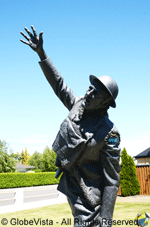Harry Murray Memorial

Public Art: Harry Murray Memorial
Sculptor: © Peter Corlett
Sculptor’s website: www.petercorlett.com
Description: A bronze statue of Australia’s mostly highly decorated soldier of World War I, Lieutenant Colonel Harry Murray (1st December 1880- 7th January, 1966) depicting him in war action. Right arm high after having just released a hand grenade and clutching in his left hand his trusty revolver.
Cost : $85,000
Date Unveiled: The memorial was unveiled on the 24th of february, 2006, by his excellency Major General Jeffery AC, CVO, MC Governor – General of the Commonwealth of Australia
Foundry: Casting by Meridan Sculpture Founders
Location: The statue of Harry Murray can be found on Main Street, Evandale, Tasmania.
Inscription:
“Capt Murray rushed to the front and rallied his men by sheer valour, with his revolver in one hand and a bomb in the other, he was ubiquitous, cheering his men, heading bombing parties, leading bayonet charges or carrying wounded from the dangerously shelled areas, with unequalled bravery. His Company would follow him anywhere and die for him to a man.”
From the citation for his Victoria Cross
Things You May Not Know About Harry Murray:
His real name was Henry William Murray.
On the 30th of September, at the age of 35, Harry enlisted for WWI. He fought in the Gallipoli Campaign, Western Front, Battle of Somme, Battle of Mouquet Farm, Battle of Passchendaele, Battle of Hamel, Battle of Amiens and the Battle of St Quentin Canal.
Harry Murray was also known as “Mad Harry” on the battle fields as he would go to extraordinary lengths and care to avoid losing any of his men.
Murray was wounded twice while fighting in Gallipoli. In the first incident he received a gunshot wound to the knee and was sent to Egypt. Despite being posted to a hospital ship set to return to Australia, Murray was going to have none of that and instead hopped on a transport bound for Gallipoli . Once again he was wounded while manning a machine gun while covering the 4th Brigades withdrawl of Hill 971. The following month he found himself once again evacuated to Egypt, this time for dysentery. Murray returned once again to Gallipoli.
Harry Murray is the most highly decorated infantry soldiers of the British Empire during World War I He is the recipient of the VC (Victoria Cross), CMG (Companion of the Order of St Michael and St George), DSO & Bar (Distinguished Service Order), DCM (Distinguished Conduct Medal) and the Croix de Guerre . He was also mentioned 4 times in Despatches.
Murray was re-enlisted during World War II and was appointed commanding officer of the 26th (militia) Battalion.